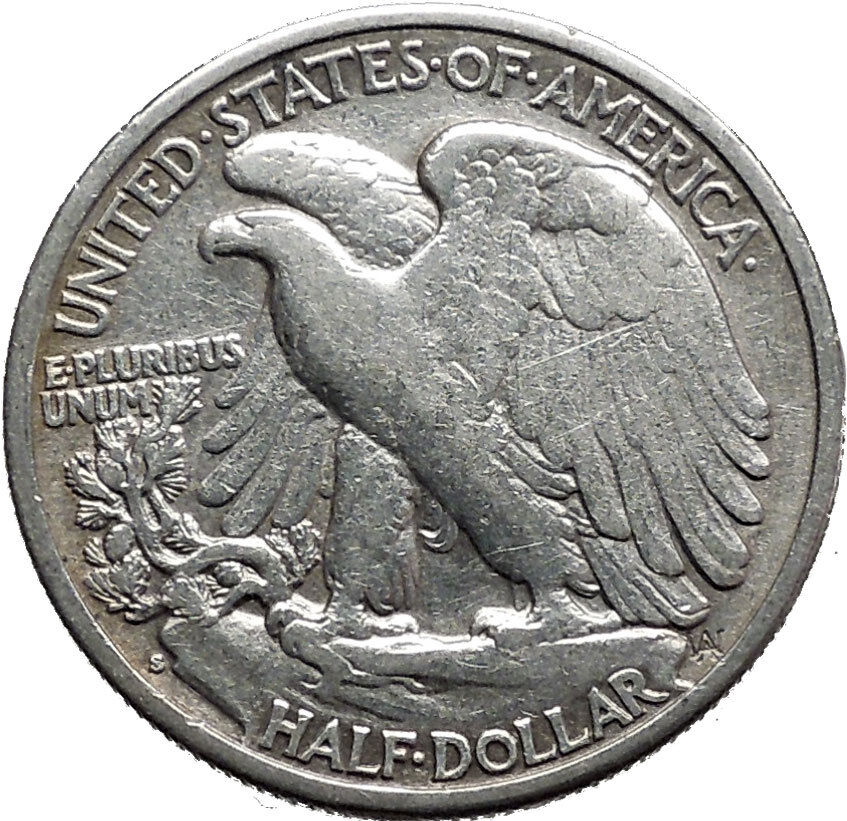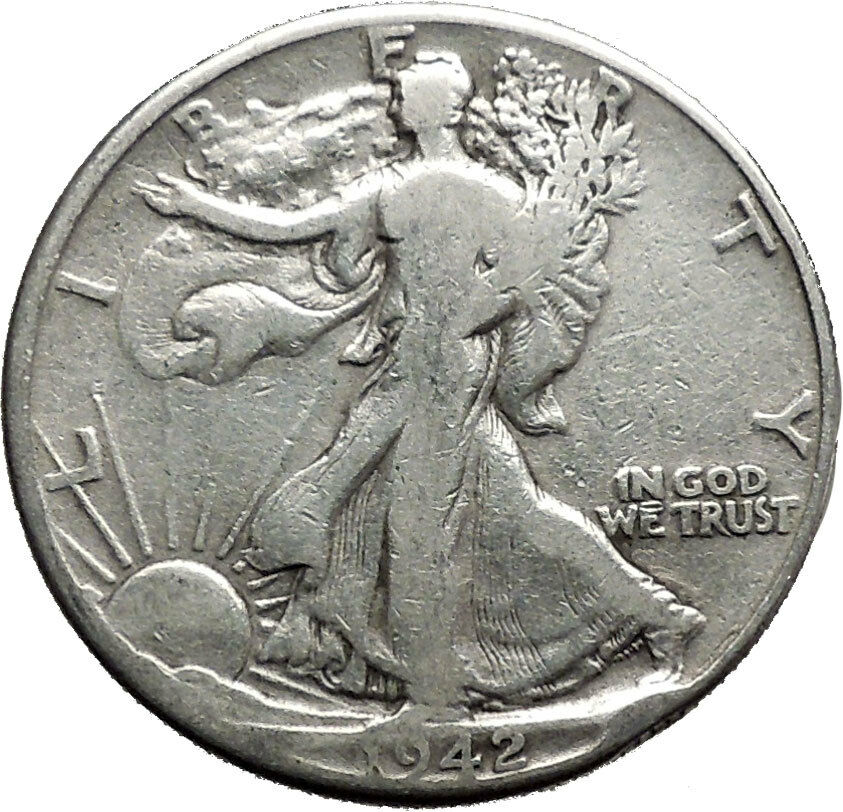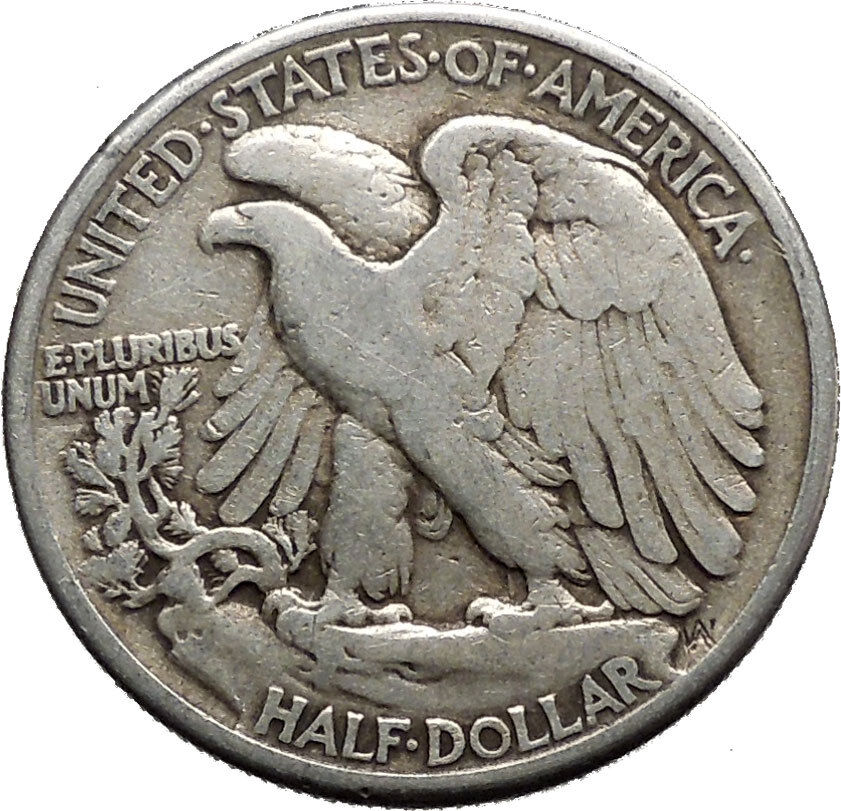|
United States of America
Walking Liberty Half Dollar
Silver Half Dollar 30mm (12.15 grams) This coin is 90% silver, and 10%
copper.
LIBERTY IN GOD WE TRUST 1944,
Lady Liberty
, the folds of the Stars and
Stripes flying to the breeze as a background, progressing in full stride toward
the dawn of a new day, carrying branches of laurel and oak, symbolical of civil
and military glory. The hand of the figure is outstretched in bestowal of the
spirit of liberty.
UNITED STATES OF AMERICA HALF DOLLAR,
a bald
eagle perched high upon a mountain crag, his wings unfolded, fearless in
spirit and conscious of his power. Springing from a rift in the rock is a
sapling of mountain pine, symbolical of America; E PLURIBUS UNUM
“out of many, one” in field to left.
A beautiful coin illustrating
true U.S. Constitutional currency which defined the dollar as a quantity of
silver. What is interesting to note is that United States of America coins,
which were dimes, quarters, half dollars and dollars were made of silver until
1964 as per the mandate of the 1792 Coinage Act. The advantage of currency
backed by precious metals being a medium of exchange that maintains and perhaps
even gains buying power over time. There was little or no inflation when the
ideals of the founding fathers were followed. The idea of paper money was a
piece of paper which was exchangeable for coins at any time. It allowed you to
easily transport your money without having to carry the weight of the gold
silver and non-precious metal USA coins.
Article I, Section. 10 of
U.S. Constitution
“No State shall enter into any
Treaty, Alliance, or Confederation; grant Letters of Marque and Reprisal; coin
Money; emit Bills of Credit; make any Thing but gold and silver Coin as Tender
in Payment of Debts; pass any Bill of Attainder, ex post facto Law, or Law
impairing the Obligation of Contracts, or grant any Title of Nobility.”
It is also interesting to note
that silver is an industrial metal and supplies are being used up at rapid
rates. Silver coins were placed in jugs of water as per it’s anti-microbial
properties. Also when cows were milked, many used or still use silver pails to
catch the milk. Silver is also used in electronics as it is non-corrosive.
Another interesting thing was that at times in history, American people were
actually able to bring their silver to the U.S. mint and get silver coins in
exchange.
The great idea of money is for
it to be plentiful to allow for easy exchange. You see, contrary to popular
belief, US money, even with the 1792 Coinage Act did have what may be described
as fiat, or coins of non-precious metal. The 1 Cent or Penny Coins were made of
copper and the 5 Cent or Nickel coins were made of nickel. However, the
brilliant thing is that the copper and nickel coins were exchangeable for silver
and gold coins. So because of this, there was gold and silver backing, in effect
for the copper and nickel coins. So the amazing thing is that there was
plentiful money, which was issued constantly and did not bear any interest for
it’s use.
So in conclusion, money is an
interesting topic of discussion and study. It can both free and enslave and
there is a lot of good in all types of systems. What is also amazing is that the
money of the United States has the words “In God We Trust”. This makes this
phrase the most written phrase in existence. The more we love people and use
money as a tool for their benefit, the better the world is becoming. We live in
an amazing time and world where we are connected via the internet and where the
best ideas are winning.
Two great documentary films to
watch on this topic is Money Masters and The Secret of Oz.
You are bidding on the exact
item pictured, provided with a Certificate of Authenticity and Lifetime
Guarantee of Authenticity.
The
Walking Liberty half dollar was a
silver
50-cent piece or
half dollar
coin
issued by the
United States Mint
from 1916 to 1947; it was
designed by
Adolph A. Weinman
.
In 1915, the new Mint Director,
Robert W. Woolley
, came to believe that he was
not only allowed but required by law to replace coin designs that had been in
use for 25 years. He therefore began the process of replacing the
Barber coinage
:
dimes
,
quarters
and half dollars, all bearing similar
designs by long-time Mint Engraver
Charles E. Barber
, and first struck in 1892.
Woolley had the
Commission of Fine Arts
conduct a competition,
as a result of which Weinman was selected to design
the dime
and half dollar.
Weinman’s design of Liberty striding towards the Sun for the half dollar
proved difficult to perfect, and
Treasury Secretary
William G. McAdoo
, whose department included
the Mint, considered having Barber create his own design. Mint officials were
successful in getting Weinman’s design into production, although it never struck
very well, which may have been a factor in its replacement by the
Franklin half dollar
beginning in 1948.
Nevertheless, art historian
Cornelius Vermeule
considered the piece to be
among the most beautiful US coins. Since 1986, a modification of Weinman’s
obverse
design has been used for the
American Silver Eagle
.
Goddesses named for and representing the concept Liberty have existed
in many cultures, including classical examples dating from the
Roman Empire
and some national symbols such as
the British
“Britannia”
or the Irish
“Kathleen
Ni Houlihan“.
Classical examples

The
ancient Roman
goddess
Libertas
was honored during the
second Punic War
by a temple erected on the
Aventine Hill
in
Rome by the father of
Tiberius Gracchus
. A statue in her honor was
also raised by Clodius
on the site of
Marcus Tullius Cicero
‘s house after it had been
razed. The figure also resembles Sol Invictus, the Roman god of sun.
Neoclassical
references
In 1793, during the
French Revolution
, the
Notre Dame de Paris
cathedral
was turned into a “Cult
of Reason” and for a time “Lady Liberty” replaced the
Virgin Mary
on several altars.
National embodiments of Liberty include
Britannia
in the
United Kingdom
, “Liberty Enlightening the
World,” commonly known as the
Statue of Liberty
in the
United States of America
, and
Marianne
in
France
.
Embodiments of the goddess Liberty in the
United States of America
include
Columbia
, which is yet another
personification
of the goddess Liberty.
The bald eagle (Haliaeetus
leucocephalus, from Greek hali- = sea, aiētos =
eagle
, leuco- = white, cephalos =
head) is a
bird of prey
found in North America. A
sea eagle
, it has two known sub-species and
forms a
species pair
with the
white-tailed eagle
(Haliaeetus albicilla).
Its range includes most of Canada and Alaska, all of the
contiguous United States
, and northern Mexico.
It is found near large bodies of open water with an abundant food supply and
old-growth trees for nesting.
The bald eagle is an opportunistic feeder which subsists mainly on
fish, which it swoops down and snatches from the water with its
talons. It builds the largest
nest
of any North American bird and the largest
tree nests ever recorded for any animal species, up to 4 m (13 ft) deep, 2.5 m
(8.2 ft) wide, and 1 metric ton
(1.1
short tons
) in weight.
Sexual maturity
is attained at the age of four
to five years.
Bald eagles are not actually
bald
; the name derives from an older meaning of
“white headed”. The adult is mainly brown with a white head and tail. The sexes
are identical in plumage
, but females are about 25 percent
larger than males. The beak
is large and hooked. The plumage of the
immature is brown.
The bald eagle is both the
national bird
and
national animal
of the United States of
America. The bald eagle appears on its
Seal
. In the late 20th century it was on the
brink of
extirpation
in the continental United States.
Populations recovered and the species was removed from the
U.S. federal government’s
list of
endangered species
on July 12, 1995 and
transferred to the list of
threatened species
. It was removed from the
List of Endangered and Threatened Wildlife in the
Lower 48
States on June 28, 2007.
The Coinage Act
or the Mint Act, passed by the
United States Congress
on April 2, 1792,
established the
United States Mint
and regulated the coinage of
the United States. The long title of the legislation is An act establishing a
mint, and regulating the Coins of the United States. This act established
the silver
dollar
as the unit of money in the United
States, declared it to be lawful tender, and created a
decimal
system for U.S. currency.
By the Act, the Mint was to be situated at the
seat of government
of the United States. The
five original officers of the U.S. Mint were a Director, an Assayer, a Chief
Coiner, an Engraver, and a
Treasurer
(not the same as the
Secretary of the Treasury
). The Act allowed
that one person could perform the functions of Chief Coiner and Engraver. The
Assayer, Chief Coiner and Treasurer were required to post a $10,000 bond with
the Secretary of the Treasury.
Although some of the provisions in the 1792 Coinage Act were adjusted as time
went by, the majority of the rules specified in this Act remained in effect for
many decades. Essentially, it provided the basic framework on which all
subsequent coinage production was based. While the first draft of the Act
stipulated that all coins would employ a portrait of the president on the
obverse, the final version called for an image emblematic of liberty. The Act
also authorized construction of a
mint building in Philadelphia
, the nation’s
capital. This was the first federal building erected under the
United States Constitution
. Mint director
David Rittenhouse
laid the building’s
cornerstone
on July 31.
On May 8, 1792 An Act to Provide For a Copper Coinage was signed into
law by President
George Washington
. This legislation resulted in
the birth of the copper cent, from which descends today’s one cent piece. The
Act also stipulated that “the director of the mint… be authorized to contract
for and purchase a quantity of copper, not exceeding one hundred and fifty
tons… to be coined at the mint into cents and half-cents… and be paid into
the treasury of the United States, thence to issue into circulation.”
Furthermore, “no copper coins or pieces whatsoever except the said cents and
half-cents, shall pass current as money, or shall be paid, or offered to be paid
or received in payment for any debt, demand, claims, matter or thing
whatsoever.”
Effects
Merchants and bankers were reluctant to bring silver bullion to the Mint
because the disclosure of the illegal silver standard that was previously in
effect. The silver coinage of 1794 and 1795 employed a 0.900 fine standard
instead of the 0.8924+ standard (317.25/416=0.89242788461) as prescribed in the
Mint Act of April 2, 1792 (Heritage Coin Auction #390, Vol III, p. 117). The
most immediate effect of this practice was that depositors ended up paying an
addition 2.5 grams of silver bullion (about 10% extra) for every dollar they
received (Taxay, 1966, p. 89). When this became widely known, bullion deposits
brought to the mint declined significantly in 1796 and 1797.
Authorization
and free coinage
The Act authorized production of the following coins:
|
Eagles
|
$10 |
247 4/8
grain
(16.0 g) pure or 270 grain (17.5
g) standard gold
|
|
Half Eagles
|
$5 |
123 6/8 grain (8.02 g) pure or 135 grain (8.75
g) standard gold |
|
Quarter Eagles
|
$2.50 |
61 7/8 grain (4.01 g) pure or 67 4/8
grain (4.37 g) standard gold |
Dollars
or Units |
$1 |
371 4/16 grain (24.1 g) pure or 416 grain
(27.0 g) standard
silver
|
|
Half Dollars
|
$0.50 |
185 10/16 grain (12.0 g) pure or 208 grain
(13.5 g) standard silver |
|
Quarter Dollars
|
$0.25 |
92 13/16 grain (6.01 g) pure or 104 grains
(6.74 g) standard silver |
|
Disme
|
$0.10 |
37 2/16 grain (2.41 g) pure or 41 3/5
grain (2.70 g) standard silver |
| Half Disme
|
$0.05 |
18 9/16 grain (1.20 g) pure or 20 4/5
grain (1.35 g) standard silver |
|
Cents
|
$0.01 |
11
pennyweights
(17.1 g) of
copper
|
|
Half Cents
|
$0.005 |
5 1/2 pennyweights (8.55 g) of copper |
The coins were to contain the following markings:
- One side was to have an impression emblematic of liberty, with the
inscription “Liberty”, and the year of the coinage.
- The reverse side of each of the gold and silver coins was to have the
figure or representation of an eagle with the inscription “UNITED
STATES OF AMERICA.”
- The reverse of the copper coins was to have an inscription expressing
the denomination.
The Act defined the proportional value of gold and silver as 15 units of pure
silver to 1 unit of pure gold. Standard gold was defined as 11 parts pure gold
to one part alloy composed of silver and copper. Standard silver was defined as
1485 parts pure silver to 179 parts copper alloy. The Act also specified the
dollar as the “money of account” of the United States, and directed that all
accounts of the federal government be kept in dollars, “dismes“,
cents
, and “milles“,
a mille being one-tenth of a cent or one-thousandth of a dollar. The silver
content of a dollar under this act was almost exactly equal to 1/5
of the silver content of the contemporary British
pound sterling
, or 4 British shillings.
Under
Sec.14
, any person could bring gold or silver
bullion and have it coined free of charge, or later for a small fee, exchange it
immediately for an equivalent value of coin. The paragraph summary states:
“Persons may bring gold and silver bullion, to be coined free of expense;”
Quality control
measures were implemented in
that from each separate mass of gold or silver used to produce coins, three
coins were set aside by the treasurer. Each year on the last Monday in July,
under the inspection of the
Chief Justice
, the Secretary and Comptroller of
the Treasury, the
Secretary of State
, and the
Attorney General
, the coins were to be
assayed
and if the coins did not meet
established standards, the officers were disqualified from office. The meetings
later became formalized as the
United States Assay Commission
, which continued
meeting until it was disbanded in 1980.
Section 19 of the Act established a penalty of death for debasing the gold or
silver coins authorized by the Act, or embezzlement of the metals for those
coins, by officers or employees of the mint; this section of the Act apparently
remains in effect and would, in theory, continue to apply in the case of “any of
the gold or silver coins which shall be struck or coined at the said mint.” (At
present the only gold or silver coins struck by the US mint are the
American Silver Eagle
and the
American Gold Eagle
coins, some
Proof coinage
at the
San Francisco Mint
, such as the silver
US State Quarters
, and much of the
Commemorative coinage of the United States
.)
All other sections of the act have been superseded, as for example the
Coinage Act of 1834
changing the silver-to-gold
weight ratio. Various acts have subsequently been passed affecting the amount
and type of metal in U. S. coins, so that today there is no legal definition of
the term “dollar” to be found in U. S. statute. Current statutes regulating
coinage in the United States may be found in
Title 31 of the United States Code
.
See also
-
Coinage Act of 1834
-
Coinage Act of 1849
-
Coinage Act of 1857
-
Coinage Act of 1864
-
Coinage Act of 1873
-
Coinage Act of 1965
-
Mill (currency)
|










